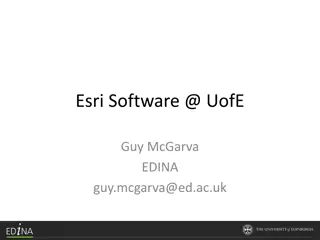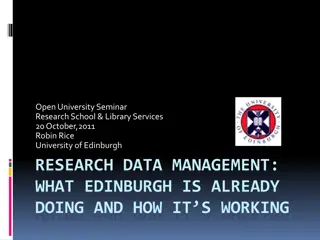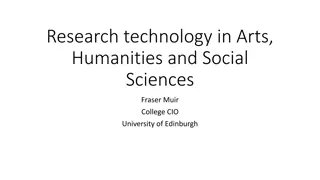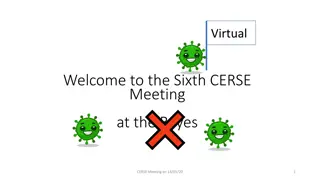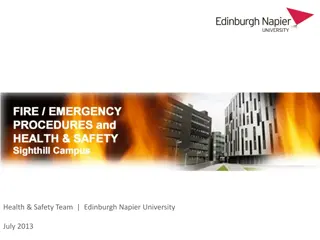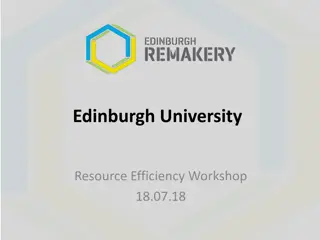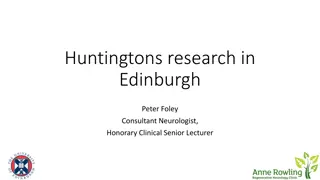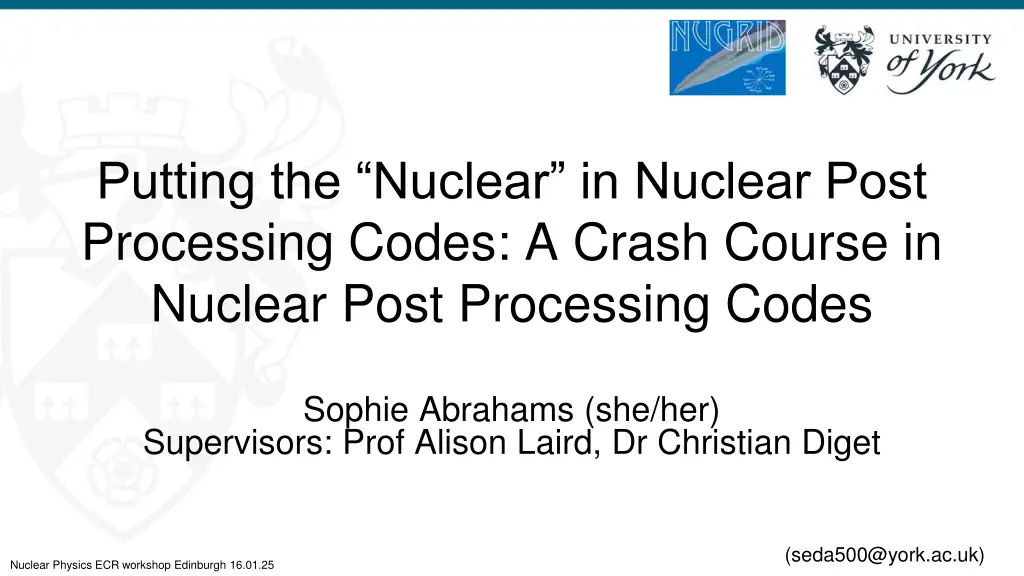
Nuclear Post-Processing Codes: Nucleosynthesis Simulation
Dive into the world of nuclear post-processing codes with Sophie Abrahams as she bridges knowledge gaps for nuclear astrophysicists. Learn how these codes function to simulate nucleosynthesis based on temperature and density evolution, guiding the sharing of new reaction rate data in nuclear astrophysics applications.
Download Presentation

Please find below an Image/Link to download the presentation.
The content on the website is provided AS IS for your information and personal use only. It may not be sold, licensed, or shared on other websites without obtaining consent from the author. If you encounter any issues during the download, it is possible that the publisher has removed the file from their server.
You are allowed to download the files provided on this website for personal or commercial use, subject to the condition that they are used lawfully. All files are the property of their respective owners.
The content on the website is provided AS IS for your information and personal use only. It may not be sold, licensed, or shared on other websites without obtaining consent from the author.
E N D
Presentation Transcript
Putting the Nuclear in Nuclear Post Processing Codes: A Crash Course in Nuclear Post Processing Codes Sophie Abrahams (she/her) Supervisors: Prof Alison Laird, Dr Christian Diget (seda500@york.ac.uk) Nuclear Physics ECR workshop Edinburgh 16.01.25
Goals of talk Bridge potential knowledge gaps that nuclear astrophysicists skip over Provide a broad introduction to how nuclear post processing codes function Point to where new reaction rate data can be shared to be used in nuclear astrophysics Sophie Abrahams Nuclear Physics ECR workshop Edinburgh 16.01.25
Nuclear post processing codes A nuclear post processing code simulates nucleosynthesis based on temperature and density time evolution of the astrophysical system of interest using nuclear data Sophie Abrahams Nuclear Physics ECR workshop Edinburgh 16.01.25
Nuclear post processing codes A nuclear post processing code simulates nucleosynthesis based on temperature and density time evolution of the astrophysical system of interest using nuclear data temperature and density time evolution Sophie Abrahams Mumpower + 2015 Physical Review C, Volume 92, Issue 3, id.035807 Nuclear Physics ECR workshop Edinburgh 16.01.25
Nuclear post processing codes A nuclear post processing code simulates nucleosynthesis based on temperature and density time evolution of the astrophysical system of interest using nuclear data nuclear post processing code temperature and density time evolution nuclear data from nuclear library Sophie Abrahams Mumpower + 2015 Physical Review C, Volume 92, Issue 3, id.035807 Nuclear Physics ECR workshop Edinburgh 16.01.25
Nuclear post processing codes A nuclear post processing code simulates nucleosynthesis based on temperature and density time evolution of the astrophysical system of interest using nuclear data nucleosynthesis evolution over time temperature and density time evolution nuclear data from nuclear library Sophie Abrahams Mumpower + 2015 Physical Review C, Volume 92, Issue 3, id.035807 Nuclear Physics ECR workshop Edinburgh 16.01.25
Uses of nuclear post processing codes Can be used to explore: Isotope production in astrophysical scenarios Observational light curves of astrophysical explosions (e.g. X-ray bursters) Energy generation in astrophysical scenarios Evolution of stars Codes which incorporate nuclear post processing Examples of nuclear post processing codes TORCH Sophie Abrahams Nuclear Physics ECR workshop Edinburgh 16.01.25
Introducing Yi(t) Track time evolution of the abundance Yi(t) of each isotope Xiin the network Abundance: Yi(t) = ni(t)/ NA where ni(t)is the number density of the isotope Assume that changes very slowly compared to Yi(t) Solves an ordinary differential equation over a set of points in time for each isotope For each isotope: J Where each summation includes all reactions which produce and destroy isotope Xi Number of isotopes tracked controlled by user Network size can range from 13 isotopes (Timmes 1999 ApJss) to 5000 (Keegans + 2019 MNRAS) Sophie Abrahams Hix et Thielemann 1999 Nuclear Physics ECR workshop Edinburgh 16.01.25
Bring in the nuclear physics! Nuclear physics is the language of nucleosynthesis - Matthew Mumpower Examples of reactions with: one reactant: alpha decay, beta decay, photodisintegration two reactants: Xi(p,n), Xi(p,a), Xi(n,g), Xi(g,p) three reactants: triple alpha reaction Examples of nuclear data required for summation of reactions with: one reactant: half life two/three reactants: integrated cross section, nuclear mass For theoretical reaction rate calculations: level density, alpha potential, isospin Hix et Thielemann 1999 https://www.matthewmumpower.com/static/pres entations/FRIB-1stexp/index.html#/nuclear- physics-inputs Sophie Abrahams Nuclear Physics ECR workshop Edinburgh 16.01.25
Solving Many potential ways to solve for Yi(t) but considerations: Constrained here by the variation in timescales over which processes happen Need the time evolution of Yito be broken into short intervals to account for changing temperature and density conditions Common methods to solve for Yi(t): Backwards Euler method Bader-Deuflhard method Kaps-Rentrop method Each method has advantages and disadvantages Accuracy, efficiency and ease of implementation are all considerations Hix et Thielemann 1999, Sophie Abrahams Timmes 1999 Nuclear Physics ECR workshop Edinburgh 16.01.25
Output from solving Wanajo + 2004 ApJl, Volume 606, Issue 2, pp. 1057-1069. wanajo et al r process.mp4 A movie from Wanajo et al. 2004, the title says "the r-process". The background is black and the text and foreground is white. The chart of nuclides is shown, with stable isotopes highlighted in white. In the bottom right hand corner a colour bar ranging from black to red to yellow to white is shown, the colour bar shows where material is moving on the chart of nuclides and what the abundance of the material is. Relevant information (time, temperature, density, neutron flux) is shown above the colour bar. In the top left hand corner is a plot with atomic number on the x-axis and abundance on the y-axis. As the movie plays, material can be seen moving away from stability and moving up the chart of nuclides on the far right hand side of the chart. The relevant information above the colour bar shows that the neutron flux is high. The plot in the top left corner shows material with a higher atomic number is being produced. Material continues to move up the far right hand side of the chart of nuclides, away from stability. Isotopes far beyond the top of the valley of stability are produced. As the neutron flux decreases, material moves to the left back towards stability, forming stable neutron rich isotopes, and long lived radioactive neutron rich isotopes. Time evolution of abundances of isotopes! Depending on the code can also output: Energy generation due to nucleosynthesis Mass fractions (where sum of all mass fractions of all isotopes = 1) Sophie Abrahams Nuclear Physics ECR workshop Edinburgh 16.01.25
Nuclear Reaction Libraries Many different nuclear reaction libraries, each nuclear post processing code uses a different combination JINA reaclib - widely used, has a set recommended rates ChANUREPS - allows for authors to upload their own rates NACRE II - charged body reactions STARLIB - calculates probability density for total reaction rate, helps with calculation of Yi(t) (Iliadis + 2015 JoP G, Vol 42, 3) ASTRAL - specialises in neutron capture rates Each library has their own process for adding rates Sophie Abrahams Nuclear Physics ECR workshop Edinburgh 16.01.25
Adjusting the 63Ga(p,g) reaction rate Ongoing work for Sivi Uthayakumaar (FRIB) Used JINA reaclib library Potential competing (p,g) and (p,a) rates Impact for how quickly material can move up the chart of nuclides to the p- nuclides Decreased (p,g) rate by an order of magnitude Goal: to observe impact on final abundances 13 Sophie Abrahams Nuclear Physics ECR workshop Edinburgh 16.01.25
63Ga(p,g) decreased by an order of magnitude PRELIMINARY 14 Sophie Abrahams Nuclear Physics ECR workshop Edinburgh 16.01.25
Summary Nuclear post processing codes use nuclear reaction rate from nuclear reaction libraries and temperature and density information to solve for the time evolution for the abundance Yiof Xi There are multiple nuclear post processing codes Can be used to understand energy generation, observational light curves, isotope production There are multiple ways to solve for Yi(t) Each method has advantages and disadvantages Nuclear inputs are vital for nuclear post processing codes New data from the nuclear experimental community drives nuclear astrophysics Sophie Abrahams Nuclear Physics ECR workshop Edinburgh 16.01.25
BRIDGCE-IReNA annual meeting - University of York 4th June - 6th June 2025 BRIdge the Disciplines related to the Galactic Chemical Evolution Nuclear experimental folks strongly encouraged to attend Master s/PhD students Scan for more info encouraged to submit abstracts Sophie Abrahams Nuclear Physics ECR workshop Edinburgh 16.01.25
Thank you to Andrs Yage L pez and Sam Jones Thank you for your attention! Sophie Abrahams Nuclear Physics ECR workshop Edinburgh 16.01.25
References Hix et Thielemann 1999, J. Comput. Appl. Math., Vol. 109, No. 1 - 2, p. 321 - 351 https://ui.adsabs.harvard.edu/abs/1999JCoAM.109..321H/abstract Mumpower + 2015, Physical Review C, Volume 92, Issue 3, id.035807 https://ui.adsabs.harvard.edu/abs/2015PhRvC..92c5807M/abstract Timmes 1999 ApJss Volume 124, Issue 1 https://ui.adsabs.harvard.edu/abs/1999ApJS..124..241T/abstract Keegans + 2019, MNRAS, vol 485, Issue 1 https://ui.adsabs.harvard.edu/abs/2019MNRAS.485..620K/abstract Iliadis + 2015, Journal of Physics G, Vol 42, 3 https://ui.adsabs.harvard.edu/abs/2015JPhG...42c4007I/abstract Sophie Abrahams Nuclear Physics ECR workshop Edinburgh 16.01.25
Goal of talk Sophie Abrahams Nuclear Physics ECR workshop Edinburgh 16.01.25





